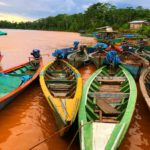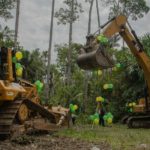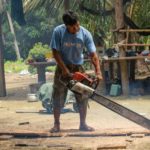The Governance and Infrastructure in the Amazon Project is led by the University of Florida Tropical Conservation and Development Program and aims to create, strengthen and expand a Community of Practice and Learning (CoP-L) for exchanges of experiences and reflection on the use of tools and strategies for infrastructure governance by conservation and development practitioners in the Amazon.
In this 6th edition of GIA’s newsletter, we present how our CoP-L works to create new and strengthen old spaces to both learn together and learn from each other, and to consolidate knowledge and collaboration around infrastructure governance. Then, we share events and news related to governance, conservation, and infrastructure in the Amazon. Happy reading!
Understanding our Community of Practice and Learning (CoP-L)
Knowledge exchange activities are important to GIA’s goal of consolidating a Community of Practice and Learning (CoP-L) around infrastructure governance. We understand CoP-L as networks of actors who interact regularly and learn together through exchanges of experiences, skills, and approaches to improve their practices. These interactions enable social learning and increase knowledge that can be applied by CoP-L participants to improve outcomes of infrastructure governance.
GIA aims to create new and strengthen old spaces for learning together and from each other to consolidate knowledge and collaboration. Activities within and across regions allow participants to learn about what others are doing, to monitor changes, and to mentor and coach others in a space conducive to self- and collective reflection.
The meaning of the “GIA Community of Practice and Learning” was co-created with GIA’s partners based on their practice and the experience of interactions at each of the focal mosaic workshops in 2019. Groups created word clouds that were placed on large banners to represent the emergent identity of each CoP-L. These events set the stage for social learning to occur throughout the lifetime of the GIA project.
Based on this understanding, one of GIA’s activities is to document how its members exchange and apply knowledge to improve infrastructure governance outcomes while consolidating the project’s CoP-L. To learn more about our conceptual ideas and theory-of-change check this document here.
Monitoring and evaluating the GIA Project
In the GIA Project, we used the broadly adopted processes of monitoring and evaluation to assess progress and document GIA’s CoP-L consolidation and changes. To that end, and in tune with GIA’s theory of change, we defined both indicators and methods considering the project and activities’ expected outcomes (Table 1).
Indicators are assessed through qualitative and quantitative methods tailored to the type of specific GIA activity implemented. For instance, for workshops and other capacity-building activities, we use Pre- and Post-surveys to gather information from participants regarding changes in skills and understanding before and after the events. Besides documenting changes, monitoring results assist the GIA’s team to recognize the project achievements and shortcomings and support its adaptive management through necessary adjustments.
We would like to share an example of how we monitored one important GIA activity from this year: The Pan-Amazon Webinar presented by GIA’s project coordinator, Dr. Robert Buschbacher, about the “Preliminary Assessment of Conservation Strategies for Infrastructure Governance in the Amazon.” Check it out here.
Learn more about news and events in the GIA Focal Mosaics!
Tabajara Dam: the next big issue
Reflecting on their research and actions in Rondonia for over a decade, Neiva Araújo and Luis Fernando Novoa Garzón, (Federal University of Rondônia – UNIR) recently published the article “Neoextractivism and hydroelectric dam projects in Rondônia: territorial developments and its political-institutional significance,” in the journal Antropolitica. The article analyzes the Environmental Impact Study and the Environmental Impact Report for the Tabajara hydroelectric dam (“UHE Tabajara”), examines the processes related to the larger Madeira hydroelectric dam complex that are on-going in the State Judiciary of Rondônia, and includes reports from affected populations, which are key elements to understand the role of the actors involved in these processes. The analysis indicates that the impacts seen in other projects could be repeated with the Tabajara hydroelectric dam.
The full article is available here. Any questions, please follow the activities of the Law, Territory & Amazon Research Group on their website (www.diterra.unir.br), Instagram (@diterra.unir) or send an email to diterra@unir.br.
New documentary on indigenous rights and the future of the Amazon
Voices on the Road is a 23-minute documentary that followed the building of a road that is quietly destroying a protected rainforest deep in the remote Peruvian Amazon, causing conflict, fear and large-scale deforestation. The road is cutting through a UNESCO World Heritage Site, the Manu Biosphere Reserve in the jungle of south-eastern Peru. Scientists predict the road will cause over 40,000 hectares of deforestation by 2040, an area equivalent to the combined size of Edinburgh and Glasgow. The all-female filming team behind the documentary spent 40 days visiting and living with indigenous communities in the remote jungle. They carried out over 50 interviews and recorded intimate personal stories as native communities struggled to protect their land and culture, feeling ignored and forgotten by the state. They uncovered stories of corruption, exploitation and a thriving black-market economy. The Peruvian government has declared the building of roads in this Amazon region a ‘national priority’ and is investing millions into road construction and improvements. Manu is on the edge of changing forever – will its diverse natural and cultural heritage survive? Check out the documentary here.




Photos credits: Archive of Voices on the Road Documentary.
Through the documentary, the producers are working to understand and support the action needed to tackle the social and environmental injustices that are taking place in the Manu Biosphere Reserve, Peru.
With the support of the IUCN NL and The Otter Foundation, the producers are developing an Impact Campaign that aims to explore the issues highlighted in the documentary and to bring a diverse range of organizations and communities together to learn, collaborate and take action.
Get involved with the Impact Campaign here.












